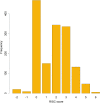Clinical pneumonia in the hospitalised child in Malawi in the post-pneumococcal conjugate vaccine era: a prospective hospital-based observational study
- PMID: 35135765
- PMCID: PMC8830243
- DOI: 10.1136/bmjopen-2021-050188
Clinical pneumonia in the hospitalised child in Malawi in the post-pneumococcal conjugate vaccine era: a prospective hospital-based observational study
Abstract
Objective: Assess characteristics of clinical pneumonia after introduction of pneumococcal conjugate vaccine (PCV), by HIV exposure status, in children hospitalised in a governmental hospital in Malawi.
Methods and findings: We evaluated 1139 children ≤5 years old hospitalised with clinical pneumonia: 101 HIV-exposed, uninfected (HEU) and 1038 HIV-unexposed, uninfected (HUU). Median age was 11 months (IQR 6-20), 59% were male, median mid-upper arm circumference (MUAC) was 14 cm (IQR 13-15) and mean weight-for-height z score was -0.7 (±2.5). The highest Respiratory Index of Severity in Children (RISC) scores were allocated to 10.4% of the overall cohort. Only 45.7% had fever, and 37.2% had at least one danger sign at presentation. The most common clinical features were crackles (54.7%), nasal flaring (53.5%) and lower chest wall indrawing (53.2%). Compared with HUU, HEU children were significantly younger (9 months vs 11 months), with lower mean birth weight (2.8 kg vs 3.0 kg) and MUAC (13.6 cm vs 14.0 cm), had higher prevalence of vomiting (32.7% vs 22.0%), tachypnoea (68.4% vs 49.8%) and highest RISC scores (20.0% vs 9.4%). Five children died (0.4%). However, clinical outcomes were similar for both groups.
Conclusions: In this post-PCV setting where prevalence of HIV and malnutrition is high, children hospitalised fulfilling the WHO Integrated Management of Childhood Illness criteria for clinical pneumonia present with heterogeneous features. These vary by HIV exposure status but this does not influence either the frequency of danger signs or mortality. The poor performance of available severity scores in this population and the absence of more specific diagnostics hinder appropriate antimicrobial stewardship and the rational application of other interventions.
Keywords: epidemiology; paediatric infectious disease & immunisation; respiratory infections.
© Author(s) (or their employer(s)) 2022. Re-use permitted under CC BY. Published by BMJ.
Conflict of interest statement
Competing interests: PI has received investigator-initiated research grant support from Bill & Melinda Gates Foundation outside the scope of this work; NC has received research grant support and honoraria for participation in rotavirus vaccine advisory board meetings from GlaxoSmithKline Biologicals and from Takeda Pharmaceuticals outside the scope of this work; NF has received investigator-initiated research grant support from GlaxoSmithKline Biologicals and from Takeda Pharmaceuticals outside the scope of this work. NBZ has received investigator-initiated research grant support from GlaxoSmithKline Biologicals, Takeda Pharmaceuticals, Merck-Sharpe-Dohme and the Serum Institute of India, all outside the scope of this work. All other authors declare that they have no financial disclosures or competing interests.
Figures
References
-
- UNAIDS . Malawi factsheet, 2019.
-
- World Bank . Prevalence of stunting - Malawi, 2018.
-
- WHO . Malawi maternal and child health data. Geneva, Switzerland: WHO, 2015.
-
- WHO . Revised who classification and treatment of childhood pneumonia at health facilities. Geneva, Switzerland: WHO, 2014.
Publication types
MeSH terms
Substances
Grants and funding
LinkOut - more resources
Full Text Sources
Medical

